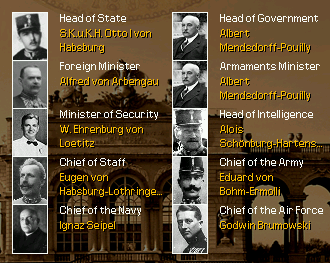Austria
From Kaiserreich
m |
|||
| Line 49: | Line 49: | ||
|- | |- | ||
|'''Area''' | |'''Area''' | ||
| - | | | + | |135 000 km² |
|- | |- | ||
|'''Population''' | |'''Population''' | ||
Revision as of 06:18, 21 October 2011
| ||||
| Motto A.E.I.O.U. | ||||
| Anthem Gott erhalte Franz den Kaiser | ||||

| ||||
|
| ||||
| Official Languages | German | |||
| Capital | Vienna | |||
| Head of State | Otto I von Habsburg | |||
| Head of Government | Albert von Mensdorff-Pouilly-Dietrichstein | |||
| Establishment - Proclaimation of the Austrian Empire | 1804 | |||
| 1867 Augsleich | May 29, 1867 | |||
| Government | Parliamentary monarchy, full constituent state of Austria-Hungary | |||
| Currency | Austro-Hungarian krone | |||
| Area | 135 000 km² | |||
| Population | About 12 millions | |||
Austria is a primary constituent of the Austro-Hungarian Dual Monarchy. It borders Germany in the north, Italian Federation in the south and Switzerland in the west. Within the dual monarchy, the areas of Bohemia, Hungary and Croatia also border Austria.
Contents |
History
Although Austria was on the winning side of the Weltkrieg, the war’s main impact was to reveal the Empire’s significant weaknesses and utter dependence upon Germany. Over the course of the 1920s one disaster followed another: Emperor Karl died in 1922 causing the throne to pass to his 10 year old son Otto; Austrian industry collapsed in face of competition from German manufactures; and the quarrels of the Czechs and ethnic Germans in Bohemia nearly pushed the Empire into civil war. Finally, the humiliation of having to call in German mediation to resolve the deadlock of the Ausgleich negotiations in 1927, which resulted in the concession of autonomy statutes given to Bohemia and Galicia, seemed to signal the end of Austria as a Great Power.
However, many feel that there is new hope for the Osterreich - now that the Emperor Otto I has come of age and the terms of the ‘Great Compromise’ are to be renegotiated at the 1937 Ausgleich next year. Could this be the time for Austria to throw off her shackles of dependence on Germany and reassert the power of the Habsburg dynasty over her Empire?
Politics
|
Emperor of Austria: His Imperial Highness Otto I von Habsburg (born 20 November 1912)
Minister-President and Minister for Finance Albert von Mensdorff-Pouilly-Dietrichstein (born 5 September 1861)
Minister for Foreign Affairs: Alfred Rappaport von Arbengau (born 16 June 1868)
Minister of the Interior: W. Ehrenburg von Loetitz
Director of the Imperial Military Intelligence: Alois Schönburg-Hartenstein (born 21 November 1858)
Chief of General Staff of the Imperial and Royal Army: Eugen von Habsburg-Lothringen (born 21 May 1863)
Commander-in-Chief of the Austrian Landwehr: Eduard von Böhm-Ermolli (born 12 February 1856)
Commander-in-Chief of the Austrian branch of the Kaiserliche und Königliche Kriegsmarine : Ignaz Seipel (born 19 July 1876)
Commander-in-Chief of the Austrian branch of the Kaiserliche und Königliche Luftfahrtruppen: Godwin Brumowski (born 26 July 1889)
Military
Army
The cisleithanian part of the Austro-Hungarian Army are the Imperial/Royal Austrian Landwehr regiments (German: "kaiserlich/königlich" or k.k., which stands for Imperial Austrian / Royal Bohemian). They consist of fifteen infantry divisions, two specialized mountain divisions and one outdated cavalry division.
Navy
The Austro-Hungarian Navy is almost completely composed of Austrian units. However, despite its growth since the reconquest of Venice in the Weltkrieg, it is considered outdated and underdeveloped when compared to the navies of the other Great Powers. Sea power has never been a priority in the Austrian foreign policy, and the navy itself is relatively little known and supported by the public. Activities such as open days and naval clubs have been unable to change the sentiment that the navy is just something "expensive but far away". Another point is that naval expenditures are for most of the time overseen by the Austrian War Ministry which is largely controlled by the army. Currently, the Austrian Navy comprise six battleships, one heavy cruiser, six light cruisers, sixteen destroyers and ten submarines.
Air Force
As for the Navy, even the Austro-Hungarian Air Forces are almost completely composed of Austrian units. The Austrian Air Force comprise two squadron of interceptors and two of naval bombers, for the support of the Navy. However, none of them is at full strength and there are no plans for an expansion in the future, as the Air Force is not considered a priority.
Foreign relations
Very good relations with Germany, Hungary, Bosnia, Bohemia, Galicia-Lodomiera, Croatia, Italian Federation and Kingdom of Spain.
Friendly relations with Bulgaria, Ukraine and Netherlands.
Unfriendly relations with Romania and Serbia.



